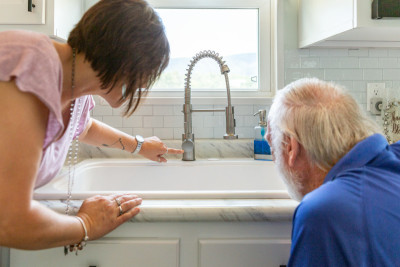Depending on the terms of your homeowners insurance policy, your policy may cover some of the cost to repair water damage caused by a covered peril. According to the Insurance Information Institute, “About one in 50 insured homes has a property damage claim caused by water damage or freezing each year.” Regardless of your coverage, water damage from burst pipes or any other unexpected event in your home can make you panic. To make it less stressful, follow our tips on what to do when you find the effects of excess water in your home.

Stop the Water at the Source
Sometimes you can't help unexpected events, like natural disasters, from causing flooding and damage to your home, but water damage from other sources can often be dealt with before they cause extensive issues.
Start by investigating where the source of the water damage may be located. Look for plumbing leaks, roof leaks, washer hose leaks or even damaged caulking that's letting water leak in.
If the source is a plumbing leak, turn off your water by locating your water shutoff valve. The location of your water shutoff valve will vary. To locate your shutoff valves try looking in the utility room, basement, or where the main water pipe enters your home.
Notify Your Insurance Company
After you've stopped the water at its source, or in the case of a natural disaster when you need help after the event, call your insurance company to report the incident and damage. Your agent will review your policy with you and help you file a claim.
Document the Damage
Move any undamaged items away from the water to prevent further damages and take photos of the area and possessions that were affected by the water leak. You will need to provide these later to the insurance company to assess your claim. Keep damaged items; they may also need to be reviewed with the photos. Doing this will also help you make a list of them later to give to your insurance.
You can drain or dry the area as best as you can afterwards.

Address Urgent Repairs
Once you turn off your water, you may temporarily repair the leak if it is a pipe leak by:
Wiping the area dry and applying epoxy to the leaking area
Then covering the leak with a rubber patch
After an hour, using water resistant tape to cover the entire area, and
Calling a licensed plumber to permanently fix the leak.
If the source of water is a roof leak, window leak or any major leak where water is entering the home from the exterior, cover the leak with water resistant material, like a tarp, dry the area and ventilate it until you can have a professional make the proper repairs. Remember to take photos of any repairs you make and get documentation from the plumber for your insurance as these repairs have not yet been authorized under your claim. Also, if you have records and documents from repairs or maintenance for the plumbing of your home, they can also be a valuable resource to help with your claim approval.
Figure Out if Your Water Source is Polluted
If your water damage came from a source like your dishwasher or freshwater line, you do not need to be concerned with potentially polluted water. However, if your water came from a sewage backup, an overflowing toilet, or from a natural disaster, the water causing havoc in your home is likely contaminated. Polluted water means your clean up and restoration process may be more extensive, and you may need to dispose of certain belongings in your home if they're damaged by the contaminated water.
It’s a good idea to be aware of what types of water damage are covered under your homeowners policy. For example, water damage due to a flood is usually covered by a separate flood insurance instead of homeowners. Talk to your agent to discuss covered perils and if you need any additional coverage.
Find Out Why You May Need Flood Coverage Outside of a Flood Zone